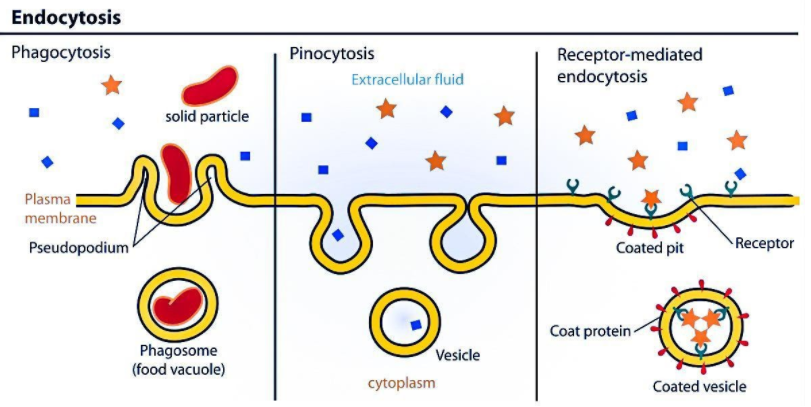
How does Amoeba obtain its food?
(a) Endocytosis
(b) Exocytosis
(c) Phagocytosis
(d) Both A and C
Answer
581.7k+ views
Hint: The process of taking food through the invagination of the membrane around it with the help of the false feet in amoeba.
Complete answer:
The food in amoeba is obtained by the process of endocytosis. Endocytosis is a cellular process where the substances are brought into the cell by a cell membrane surrounding the cell. These cell membranes then break off and form a vesicle surrounding the food material.
Additional information 1. The term endocytosis was proposed by De Duve in 1963. Endocytosis is of two types:
(a) Pinocytosis – is also known as fluid endocytosis. It is the process in which the small suspended particles present in the extracellular fluid are taken into the cell through the invagination of the cell membrane. This leads to the formation of small vesicles containing a suspension of the particles.
(b)Phagocytosis – it is a Greek word meaning “to eat”. In this process, there are certain living cells which are called phagocytes engulf the cells or other particles. It is a defense mechanism against certain infections in the case of higher animals.
2. The amoeba engulfs food with the help of pseudopodia and then it forms a vesicle around it.
3. When the particle is inside the vesicle, amoeba secretes digestive enzymes that digest the food particle.
So, the correct answer is ‘Both A and C'.

Note: The opposite of endocytosis is exocytosis. Exocytosis is a type of active transport where cells transport molecules out of the cells which requires energy. This process takes place for those molecules which move against the gradient in a large amount. The term exocytosis was proposed by De Duve in 1963.
Complete answer:
The food in amoeba is obtained by the process of endocytosis. Endocytosis is a cellular process where the substances are brought into the cell by a cell membrane surrounding the cell. These cell membranes then break off and form a vesicle surrounding the food material.
Additional information 1. The term endocytosis was proposed by De Duve in 1963. Endocytosis is of two types:
(a) Pinocytosis – is also known as fluid endocytosis. It is the process in which the small suspended particles present in the extracellular fluid are taken into the cell through the invagination of the cell membrane. This leads to the formation of small vesicles containing a suspension of the particles.
(b)Phagocytosis – it is a Greek word meaning “to eat”. In this process, there are certain living cells which are called phagocytes engulf the cells or other particles. It is a defense mechanism against certain infections in the case of higher animals.
2. The amoeba engulfs food with the help of pseudopodia and then it forms a vesicle around it.
3. When the particle is inside the vesicle, amoeba secretes digestive enzymes that digest the food particle.
So, the correct answer is ‘Both A and C'.

Note: The opposite of endocytosis is exocytosis. Exocytosis is a type of active transport where cells transport molecules out of the cells which requires energy. This process takes place for those molecules which move against the gradient in a large amount. The term exocytosis was proposed by De Duve in 1963.
Recently Updated Pages
Master Class 11 Social Science: Engaging Questions & Answers for Success

Master Class 11 Physics: Engaging Questions & Answers for Success

Master Class 11 Maths: Engaging Questions & Answers for Success

Master Class 11 Economics: Engaging Questions & Answers for Success

Master Class 11 Computer Science: Engaging Questions & Answers for Success

Master Class 11 Chemistry: Engaging Questions & Answers for Success

Trending doubts
What is meant by exothermic and endothermic reactions class 11 chemistry CBSE

10 examples of friction in our daily life

One Metric ton is equal to kg A 10000 B 1000 C 100 class 11 physics CBSE

Difference Between Prokaryotic Cells and Eukaryotic Cells

1 Quintal is equal to a 110 kg b 10 kg c 100kg d 1000 class 11 physics CBSE

Draw a diagram of nephron and explain its structur class 11 biology CBSE




